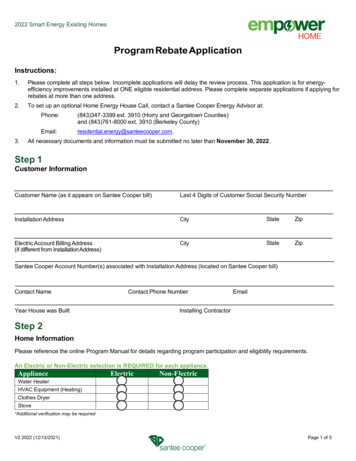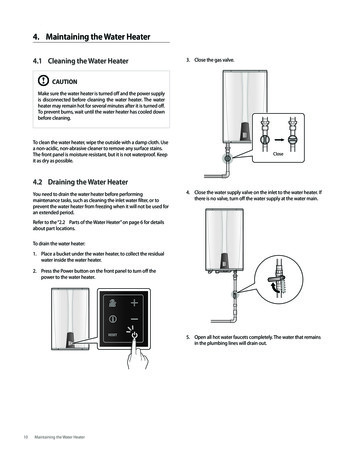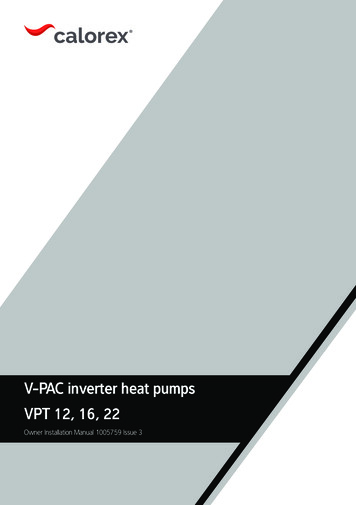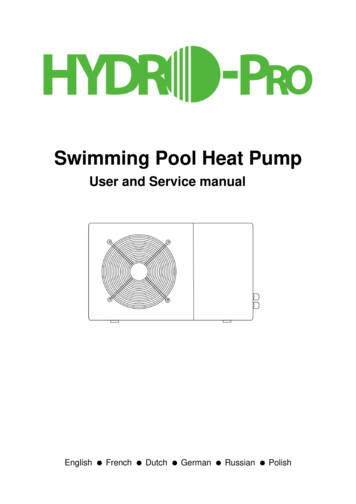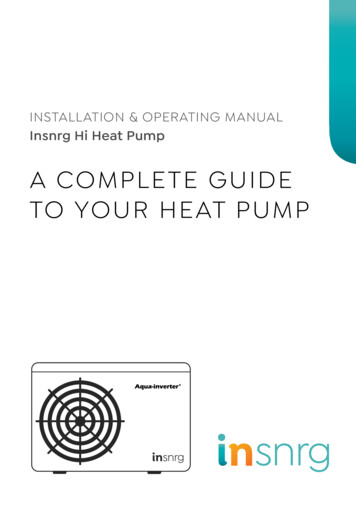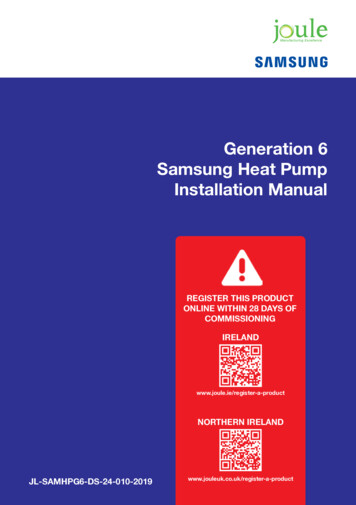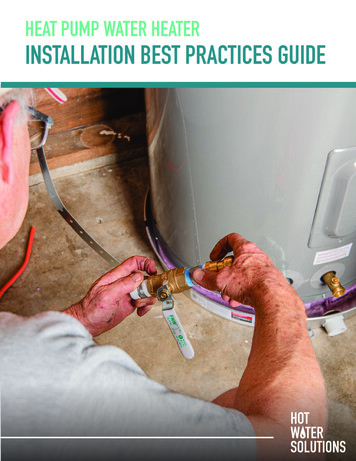
Transcription
HEAT PUMP WATER HEATERINSTALLATION BEST PRACTICES GUIDE
HEAT PUMP WATER HEATERSARE A PROVEN TECHNOLOGYKNOWN TO IMPROVEENERGY EFFICIENCY.Heat pump water heaters are more available,efficient and reliable than ever, with mostproducts carrying a 10-year warranty. Aswater heating accounts for nearly 20% ofhome energy use, this appliance can havea significant impact on lifetime energy use.While installing a heat pump water heateris like installing a standard electricwater heater, there are some importantconsiderations detailed in this guide.These include condensate management,proper sizing, and selecting the bestinstallation location to enhanceperformance and customer satisfaction.HEAT PUMP WATER HEATER FEATURES AND BENEFITS Reduce energy consumption and operatingcosts by up to 60% compared to standardelectric water heaters Avoid the need for venting andcombustion condensate management Achieve more hot water delivery capacitythan standard electric resistance tanks Most heat pump water heaters come with aminimum 10-year manufacturer warranty ontank and parts2 Easily set the temperature and changeoperational modes to maximize efficiencyusing the digital touchscreen control panel,delivering much more flexibility than standardelectric water heaters Wi-Fi connectivity and smartphone app(availability varies by model) to remotelychange temperatures, engage vacationmode, and monitor performance Leak detection (some models)
HOW IT WORKS:THE ANATOMY OF A HEAT PUMP WATER HEATERStandard electric water heaters require a substantial amount of energy to heat water. In contrast, heat pumpwater heaters use less than half the energy to heat the same amount of water. By extracting heat from thesurrounding air and transferring it to the water inside the tank, heat pump water heaters can significantlyreduce the amount of heat that must be created.1Air InFans pull warmth from theair into the heat pump.Cooler Air OutaFilterbcHeat PumpHot Water Out23The heat is transferred towater in the storage tank.Condenser CoilHot water is nowready to use.deStorage TankfCold Water InKEY DIFFERENCES FROM STANDARD WATER HEATERSa. Filter cleaning required, along with sufficientspace aboved. May require a little more physical spaceand sufficient make-up air spaceb. Cold exhaust aire. Modest amount of noisec. Digital control panelf. Side piping on most units3
INSTALLATION CONSIDERATIONSHeat pump waters heaters have some uniqueinstallation considerations compared to standardelectric or gas water heaters, including installationlocation, air exhaust, and sound.Space and LocationManufacturers typically require 700 cubic ft. ofair volume in the space where the water heateris installed, along with sufficient space to allowinstallation and service. For a house with 9-ft.ceilings, this translates to a 9x9 ft. room. Garagesare ideal locations, providing ample space forheat pump water heaters. For houses in colderclimates, such as east of the Cascades, considerthe possibility of freezing conditions in the garageand follow standard location practices in yourarea. Basements, utility rooms, and laundry roomsalso offer excellent locations for the water heater.Be sure to consult the manufacturer’s installationguide for recommendations specific to your model.For further considerations, reference the FAQsection beginning on page 9.Cool Exhaust AirHeat pump water heaters exhaust air that is coolerthan their surroundings. Therefore, they should notbe located in rooms that are frequently occupied.When garage installations are not available,basements, utility, and laundry rooms also serve asexcellent locations.Tank SizeFirst, follow the local plumbing code as you wouldany other water heater. To size a heat pump waterheater to meet demand, consider the number ofback-to-back showers that might take place in ahousehold. A 50-gallon tank is enough for up totwo consecutive ten-minute showers; a 65-gallontank will work for 3 ten-minute showers; and an80-gallon tank is suitable for 4 or more consecutiveshowers. For maximum efficiency, considerupsizing the tank over your standard practice. Heat4pump water heaters typically come with auxiliaryresistance elements to meet periods of increasedwater demand. This operation is far less efficientthan running in heat pump mode alone. Upsizingthe tank will minimize inefficient resistance heating,allowing the heat pump to do most of the waterheating work.TANK SIZING GUIDELINESNumber of ConsecutiveAppropriate10-minute ShowersTank Size1-250-gallon365-gallon4 80-gallonSoundHeat pump water heaters have a fan andcompressor, both of which make noise. Mostheat pump water heaters emit sound at levelsless than 55 dBA. Standing on the other side ofa wall or door, the sound level drops to 35–40dBA, which is quieter than a refrigerator. Still,placing the water heater away from bedroomsand living rooms can help mitigate any potentialsound issues. Check with manufacturers forbest practices regarding isolation pads, foam,and mounting strategies.Heat PumpWater HeaterWallReducedNoise
CONDENSATE PIPE ROUTING TIPSBY WATER HEATER LOCATIONAbove Grade (e.g., garage) I nstall to ensure drain line won’t freeze(consult installation manual for best practices) Laundry and/or sink drainINSTALLATION BEST PRACTICESInstalling a heat pump water heater is essentially thesame as installing an electric resistance water heater,so no additional trades or special skills are neededon site. Installation is simple, with no refrigeranthandling required. In addition to following theguidance of product manuals, consider the followingbest practices:Below Grade (e.g., basement) Drain to floordrain,CondensateTip#1 laundry sink and/orp-trap to plumbing lineFor added utility, consider drainingtheoutside towithirrigate Pcondensateump to outsidecondensatethe landscape. For additionalpumpClearance and Positioning Follow manufacturer specifications regardingwater heater clearance and local code forseismic strappingbenefit to the homeowner, installthe condensate drain with a p-trapand a tee port opening so thehomeowner can periodically flushthe condensate line with vinegaror similar cleaning solution.CONDENSATETIP #1For added utility, consider draining thecondensate outside to irrigate the landscape.For additional benefit to the homeowner,install the condensate drain with a p-trap andCondensateTip #2a tee port openingso the homeowner canCondensate pumps, commonlyperiodically flush the condensate line withpaired with air conditioners, canvinegar o r similar cleaning solution.be used to drain the condensate Position the unit so the control panel is facingoutward and easily accessible to the homeowner Make sure all data connection ports are accessible Aim the exhaust air away from the center of theroom, where it might blow on someone walkingby, and so it does not discharge directly into awall, which can cause a continual lowering ofintake air temperature Ensure the intake air path is sufficiently freeand open Make sure the positioning allows for easy accessto inspect the water heater and controls, changethe air filter, and drain the tankproduced by a heat pumpwater heater. A single pump mayoften be used for both the airconditioner and the heat pumpwater heater.CONDENSATETIP #2Condensate pumps, commonly paired withair conditioners or condensing furnaces, canbe used to drain the condensate producedby a heat pump water heater. A singlepump may often be used for both the airconditioner and the heat pump water heater.CondensateHeat pump water heaters produce a neutralcondensate that must be drained away from thewater heater. Generally these products only producea couple cups of water per day during the late springthrough early fall seasons. Unlike condensing gaswater heaters, which produce acidic condensate as acombustion byproduct, there are no special piping orhandling requirements for heat pump water heatersother than to convey the neutral condensate to adrain. However, it is important to make sure the tankis level to ensure the evaporator drain pan drainsproperly. Also note condensate is not produced invery cold weather.5
Insulation PadNo Stand NeededProvide minimum R-10 foam pad under the heatpump water heater to minimize unnecessary heatloss through the bottom of water heater. This is abest practice regardless of floor type, and R-10foam pads are readily available at plumbing supplycenters.Electric storage water heaters with lower elementsabove 18”, including heat pump water heaters,do not need to be raised off the floor with a stand.That requirement was a safety provision for olderatmospheric gas storage water heaters located ingarages. Most electric heat pump water heatersare taller than electric storage water heaters —they have the same nominal volume, but theirconnections are in different places. Make surethere is space above and around the heater toaccommodate the variations for the models youare considering.Drain PanIf installing on a floor susceptible to water damage,install a drain pan to guard against any problemsfrom future leaks. Connect the outlet from thepan to suitable drainage in accordance with yourlocal code.Seismic StrappingAs with other water heaters, your local code may require seismic strapping. When installing, use rubberstandoffs when attaching straps to the wall to minimize the vibration and transfer of sound to rest of house.6
Pipe InsulationInsulate the hot water piping to atleast the minimum requirements inaccordance with your local code.To improve the system performanceoverall, insulate all of the hot waterpiping. It is more important to makesure the pipe insulation is continuousthan it is to increase the wall thicknessor R-value of the pipe insulation.Heated Water Circulation(Temperature Maintenance)After Installation:Servicing the Water HeaterDo not use a continuously operated circulationpump (this is prohibited under some states’ energycodes). If pipe runs to fixtures that are too long,use a demand-, sensor-, or occupant-activatedpump to circulate just enough water to prime theloop with hot water. Connect the return pipe of thecirculation loop to the cold inlet of the water heater— this will guide the cooler returning water to poolat the bottom of the tank so it does not interferewith hot water availability. Continuous circulation isparticularly detrimental to heat pump water heatersand will result in lack of hot water availability andgreatly increase energy use. Consequently, neverset the circulation system controls to continuousand advise the homeowner to do the same.Most heat pump water heaters come with a 10year equipment warranty. After installation, heatpump water heaters require modest servicing.The air filter should be cleaned every 3–6 months,with a more frequent cleaning cadence in highdust locations. The heat pumps in current waterheaters are designed like refrigerators to operateas a fully sealed system with no servicing, sothere are no ports to add or remove refrigerant.On extremely rare occasions, the homeowner mayhave to clear the condensate drain port shouldit become blocked. Like any other water heater,follow the manufacturer’s recommended servicerequirements including regular maintenance fordraining the tank and servicing the anode rod.7
FINAL INSTALLATION CHECKLISTBased on the considerations and best practices outlined above, thefollowing checklist provides guidance on verifying the proper installation:Condensate safely conveyed to drain or exterior. (Note:condensate is neutral water and does not require specialpipe material).Proper wire gauge is used. (Note: Most heat pump water heatersstill have full-size resistance elements, so wiring requirements areidentical to standard electric-resistance water heaters).T&P valve is properly plumbed.Wiring is grounded with proper gauge.Water heater is on minimum R-10 foam pad if in unconditionedspace or on concrete floor.Seismic strapping is employed, as required by local jurisdiction.Pipe insulation is minimum R-3 or local code —whichever is greater.Correct space is provided around the heat pump(per manufacturer’s instructions).Heated water circulation systems, if present, are configured topump only on demand for hot water within the occupancy.Recirculation loop (if present) returns pipe to cold inletof water heater.Water heater is positioned with clear intake air path,and oriented to minimize exhaust air drafts.Water heater is positioned for easy access to the controlpanel and to change or service the filter.Connections to the water heater are located so that the waterheater can be easily removed for repair or replacement.Make-up air volume around the water heater is large enough, ormake-up air is provided as per the manufacturer’s requirements.Mode of operation is set to hybrid at a minimum, and preferablyto heat-pump only.
FREQUENTLY ASKED QUESTIONSWill the heat pump water heater reduce thetemperature of the room it’s located in?Heat pump water heaters work efficiently byextracting heat from the surrounding air andtransferring it to the water inside the tank. In anopposite manner, refrigerators work by extractingheat from inside the refrigerator and transferring itto the kitchen. Just as refrigerators do not makethe kitchen noticeably warmer, heat pump waterheaters do not typically make the room in whichthey’re located noticeably colder.If installed inside the house, will the heatpump water heater’s energy savings beoffset by the extra heating system runtime?Installed inside the house, the heat pump waterheater will use some energy provided by theheating system in the winter and reduce some ofthe cooling system in the summer. Additionally,the heat pump water heater can make use ofexcess heat in the house from solar sources,other appliances, and even the ground. The moreefficient the space-heating system is, the betterthe benefit for the heat pump water heater and thesmaller the heating offset. Regardless of spaceheating system, the energy savings from the heatpump water heater far exceed any additionalenergy needed from the heating system.Are heat pump water heaters loud?Heat pump water heaters have a fan andcompressor, both of which make noise. Most heatpump water heaters emit sound at levels less than55 dBA, which is quieter than a typical conversation.On the other side of a wall or door, this drops to35–40 dBA, which is quieter than a refrigerator.Can I reduce the sound?To mitigate heat pump water heater sound levels,locate the unit far away from the most activelyoccupied areas of the house. Additionally, usevibration dampening standoffs to connect theseismic strapping from the water heater to thewall. Placing the water heater on an insulating padwill also help. Attaching a short duct run, suchas a 90-degree elbow, can reduce sound. Finally,insulating the walls between the installation locationand occupied spaces of the house can reducesound levels.How reliable are heat pump water heaters?Heat pump water heaters have been availablefor more than 40 years. Current heat pump waterheaters are designed like refrigerators to operate asa fully sealed system with no servicing required. Theonly additional, regular service needed is to checkthe air filter every 3 months. Further, most heatpump water heaters come with a category-leading10-year warranty.Will the occupants have enough hot water?Heat pump water heaters have hot water deliverycapability that is comparable to or greater thanelectric-resistance tanks. Follow the tank-sizingguidelines on page 4.When should I go to a bigger tank?If space, budget and location allow, a larger tank isthe better choice as they rely on the heat pump forthe majority of, if not all, the water heating.What if I need more hot water but can’tinstall a larger tank?One approach is to install a whole house temperingvalve, which allows a higher set point on the waterheater. Higher temperatures may result in smallperformance penalties. Always consult with localplumbing codes to guide professional installationand fail-safe equipment.9
I have a 600 sq. ft. ADU and thehomeowner wants a heat pump waterheater. Where do I locate the unit, andwhat other installation considerations arethere for installing in a small space?If you are installing a heat pump water heater ina small space, consider installing it in an areathat will not be impacted by a modest amountof noise and or cool air while operating (e.g.,a kitchen closet with louvered door). Otherinstallation locations to consider may include: Closet with venting in and out ofthe structure Sufficiently large crawl space Adjacent semi-conditioned garage withenough volume of air (700 cubic feet) Conditioned space outside that doesn’tfreeze (in this case, the unit will need to beset in Hybrid mode (heat pump water heaterand electrical resistance)Where can I find additional information? General information:HotWaterSolutionsNW.org List of Qualified Products: neea.org/img/documents/qualified-products-list.pdf Installation help: f Heat Pump Water Heater Handbook fromthe American Council for an Energy EfficientEconomy 2018 Summer Study on Buildings(Widder and Larson) AO Smith: aosmith.com Bradford White: bradfordwhite.com Rheem: rheem.com Sanden: sandenwaterheater.com ENERGY STAR : EnergyStar.govHot Water Solutions is an initiative of the Northwest Energy EfficiencyAlliance (NEEA) working to accelerate the adoption of heat pump waterheaters in the Northwest by providing resources, tools and support toincrease sales and installations of heat pump water heaters.To learn more, visit HotWaterSolutionsNW.org
After Installation: Servicing the Water Heater Most heat pump water heaters come with a 10-year equipment warranty. After installation, heat pump water heaters require modest servicing. The air filter should be cleaned every 3-6 months, with a more frequent cleaning cadence in high dust locations. The heat pumps in current water
